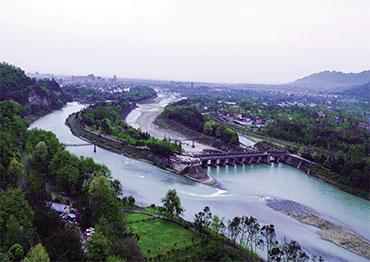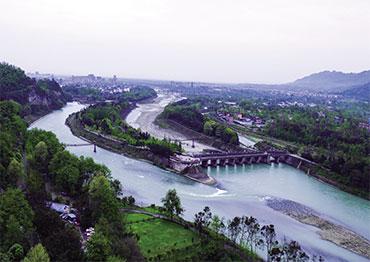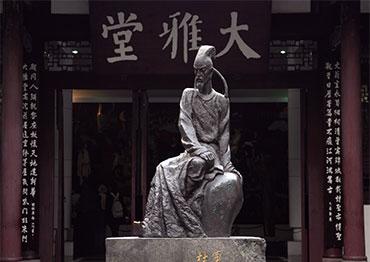Don’t go to Chengdu. Well, actually, do go. Just don’t go there when I did. Don’t go there in the middle of the National Day weeklong holiday. And especially don’t go in the middle of the National Day holiday while the world is battling a pandemic and all the borders are shut.
You’ll still have a nice time if you do, you’ll just be having a nice time despite the heaving crowds, which somewhat obscured what surely must count among China’s hippest and most laid-back metropolises in Sichuan Province.
Unfortunately for me, I wasn’t able to read this article before I went, so every single tourist attraction I visited was completely packed. This had a bigger impact on some attractions than others.
I was still able to appreciate the awesome achievement that is Dujiangyan, for instance. At first, I did wonder why we’d taken a bus to the suburbs to look at a rather plain island in the Min River. I also wondered why, according to the museum, a whole host of foreign heads of state had also been brought along, from thenvice president Joe Biden to late North Korean leader Kim Jong-il.
All became clear when I looked the place up on my phone (as is typical of tourist sights in China, the explanations on offer are cursory at best). The island was man-made, part of a huge effort to control flooding and irrigate farmland commissioned in 256 BC by King Zhao of Qin – who laid the groundwork for the unification of China by his grandson, the first emperor of China, Qin Shi Huang. Besides the vast toil and precision it took to build the island, which acts as a levee to split the river into fast- and slow-moving channels, the project required a 20-meter channel be slashed through a mountain of solid rock.
Given that explosives hadn’t yet been invented, the engineers successively heated the rock with fire and cooled it with water, until it cracked bit by bit. It took over eight years.
The system is still working and making Sichuan fertile to this day. It’s a great place to go to be impressed with the achievements of Chinese governments – I can see why they take heads of state there.
Rather more spoiled by the crowds was Du Fu’s Thatched Cottage. The Ming-reconstructed, Qing-renovated one-time residence of Tang dynasty poet Du Fu could offer travelers a quiet, contemplative oasis in the city. If it was quiet. Which it wasn’t when I visited. Given it’s a major tourist spot, I imagine it rarely is. There’s little to explain who Du Fu was, what made his poems great, or the extent of his large influence on Chinese culture. There aren’t really any poems on display. There are several signs explaining how big the buildings are.
The Chengdu Research Base of Giant Panda Breeding fell somewhere in-between. While I did sometimes feel like I was riding a rush-hour subway as the momentum of the crowd carried me from a snoozing panda to a chewing panda to yet more snoozing pandas, it could be argued that being part of a huge gawking crowd that oohs and aahs at every grunt does really bring home that you’re looking at a celebrity animal. Standing on a red carpet among throngs of adoring fans must feel similar.
But one doesn’t really visit Chengdu for the tourist spots. You go for the eats and the vibes.
Both are top-notch.
There’s nothing I can say about the famously spicy Sichuanese food that hasn’t been said a thousand times before. But I will say that, unsurprisingly, it's better in Sichuan than anywhere else I’ve had it. It's nearly impossible to find a bad bite in Chengdu (though I wasn’t actually seeking one out). We had a great mapo tofu at one of the several branches of Chen Mapo Tofu, which claims to have invented the dish. We enjoyed hearty pig’s foot stew at one of many latenight-only restaurants, where groups of young people try their hardest to get drunk on barelyalcoholic Snow beer.
The culinary highlight for my wife was the local take on guokui flatbreads. Chengdu’s are about six inches in diameter and thicker than the paper-thin version popular up north. They come generously stuffed with your choice of chili-oil drenched fillings, which range from wood-ear fungus to pig's-head meat. We just grabbed them where we saw them, but apparently some of the finest are served at Yan Taipo near the Wenshu Monastery.
For me, the highlight was big bowls of dan dan noodles (treat yourself by always going for three liang, or 150 grams) enjoyed on sidewalk stools, washed down with pints of not-very-Sichuanese bubble tea at one of dozens such joints scattered around the city. What was particularly pleasing about this meal (which I insisted on repeating exactly the following day) wasn’t the (delicious) food but soaking in the atmosphere of a city where people love chilling on the street.
Chengdu is not only unusual among big Chinese cities in leaving its laid-back street culture unrectified; it was actively nurturing it when I was visiting. Eager to get people out of their homes and spending cash in the wake of the domestic coronavirus epidemic, the city government encouraged people to set up street stalls selling snacks as well as less digestible commodities.
So, as I said, don’t visit Chengdu in the middle of the National Day holiday. Go immediately. From now until June is the best time to visit, after the winter rain has left and before the notoriously sweltering summer begins.
As capital of Sichuan Province, the city is easily reached. If your city isn’t connected to Chengdu by direct flight, another nice option could be to fly into the better-connected Guangzhou international airport and take a day traveling up by high-speed rail through the scenic karst peaks of Guangxi Zhuang Autonomous Region and Guizhou.
If you’re the sort of person who likes to stay in a hotel which people describe using words like “historic,” “curated” and “minimalist,” you might want to consider booking a room at the Temple House. Based in a traditional-style building that dates back to the Qing Dynasty, this hotel combines authentic Chinese aesthetics with all the mod-cons you expect from a high-end luxury hotel. Spa, indoor pool, inhouse Italian fine dining – it’s all there. However, bookings are pricey and spaces fill up fast at peak times.
If, like me, you prefer a more affordable option that still offers convenience, comfort and cleanliness, I recommend the Huanhua Jincheng hotel on Baihua West Road. Located just outside downtown and adjacent to both the Jin River and various parks, you can walk to several sights within half an hour and are just five minutes away from a subway stop to go further afield. A particular nice touch is the complimentary laundry service.

 Old Version
Old Version

